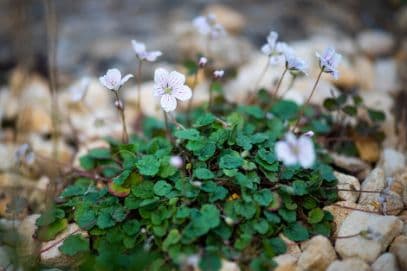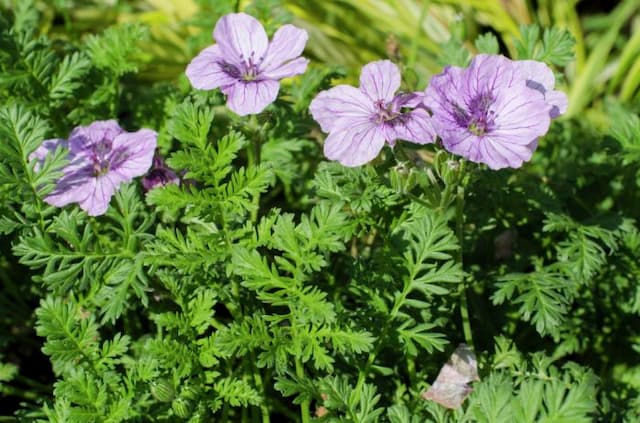Wood Crane's-bill Geranium sylvaticum 'Coquetdale Lilac'

ABOUT
Geranium sylvaticum 'Coquetdale Lilac', commonly known as the woodland geranium, boasts a charming aesthetic that contributes to its popularity in gardens. It is characterized by its beautiful foliage and the lilac-colored flowers that it proudly displays. The leaves of this plant are attractively divided and deeply lobed, creating a textured, feathery look. They typically have a rich green color which can turn into lovely hues of red and orange as the cooler weather sets in. The flowers of 'Coquetdale Lilac' form an equally compelling display. The blooms are a delicate lilac or pale purple color, with each flower consisting of five rounded petals that are veined with darker lines, creating a striking contrast. These flowers are grouped in loose clusters, which give the plant a whimsical and somewhat informal appearance. Additionally, these blossoms are known for their extended flowering period and their ability to attract pollinators such as bees and butterflies, adding dynamism to the garden. The woodland geranium is also appreciated for its hardiness and its ability to adapt to various garden conditions, making it a versatile choice for gardeners. Overall, the appearance of Geranium sylvaticum 'Coquetdale Lilac' is one of gentle beauty, with its combination of delicate flowers and intricate leaves bringing a touch of the wild woodland into the cultivated garden space.
About this plant
 Names
NamesFamily
Geraniaceae.
Synonyms
Wood Cranesbill, Forest Geranium, Woodland Geranium.
Common names
Geranium sylvaticum
 Toxicity
ToxicityTo humans
Wood cranesbill is not considered toxic to humans, and there are no well-documented cases of poisoning from the ingestion of this plant. As with any plant material, individual sensitivities and allergic reactions can occur, but these are typically not severe. Always exercise caution and avoid ingesting plants that are not specifically grown for consumption to prevent any potential adverse effects.
To pets
Wood cranesbill is generally considered non-toxic to pets as well. It does not contain any known toxic compounds that would pose a risk to animals if ingested. However, as with any non-food plant, consumption of large amounts might cause mild gastrointestinal upset, such as vomiting or diarrhea, due to the novelty and fibrous nature of the plant material rather than toxicity. If you observe any adverse reactions in your pet after ingestion, it is always best to consult with a veterinarian.
 Characteristics
CharacteristicsLife cycle
Perennials
Foliage type
Deciduous
Color of leaves
Green
Flower color
Lilac
Height
2 feet (0.6 meters)
Spread
1 foot (0.3 meters)
Plant type
Herb
Hardiness zones
3
Native area
Europe
Benefits
 General Benefits
General Benefits- Aesthetic Appeal: Geranium sylvaticum 'Coquetdale Lilac', commonly known as woodland geranium, adds a touch of delicate lilac to garden spaces with its soft-colored flowers.
- Attracts Pollinators: The blossoms of woodland geranium attract bees and butterflies, promoting pollination in the garden.
- Low Maintenance: Woodland geraniums are known for being hardy and requiring minimal care, which makes them suitable for gardeners of all skill levels.
- Drought Tolerant: Once established, these plants can tolerate periods of dry weather, reducing the need for frequent watering.
- Natural Ground Cover: The plant spreads to form a dense ground cover, which can help suppress weeds and protect soil from erosion.
- Cold Hardy: Woodland geranium can survive in cooler climates and tolerate frost, making it a great choice for northern gardens.
- Long Blooming Period: This plant has a lengthy blooming time from late spring to early summer, providing extended visual interest.
- Companion Planting: Its subtle color and growth habit make it an excellent companion for other plants, enhancing overall garden design.
 Medical Properties
Medical Properties- This plant is not used for medical purposes.
 Air-purifying Qualities
Air-purifying QualitiesThis plant is not specifically known for air purifying qualities.
 Other Uses
Other Uses- Decorative Ice Cubes: Flowers of the wood cranesbill can be frozen into ice cubes to add a splash of color and elegance to summer drinks.
- Natural Fabric Dye: The petals can be used to produce a natural dye for coloring fabrics a subtle shade of blue or purple.
- Ink Making: Historically, the pigments from the wood cranesbill might have been used to make inks for writing and art.
- Plant Stamps: The leaves can be used to create natural stamps for crafting, where their unique shape can be imprinted on paper or fabric.
- Garden Design: Its striking lilac flowers can be used to create a 'wild' garden look or a woodland aesthetic within landscape design.
- Companion Planting: The wood cranesbill can be planted alongside vegetables to attract beneficial insects that prey on garden pests.
- Educational Tool: This plant can be used to teach children about the pollination process, as it is attractive to bees and butterflies.
- Photography Subject: Its vibrant flowers and foliage make it a popular choice for photographers seeking to capture the essence of spring.
- Culinary Garnish: Edible flowers of the wood cranesbill can be used to garnish desserts and salads, although moderation is key as it is not commonly consumed.
- Floral Arrangements: Fresh or dried, the flowers can be a delicate addition to floral arrangements, giving them a rustic charm.
Interesting Facts
 Feng Shui
Feng ShuiThe Wood Cranesbill is not used in Feng Shui practice.
 Zodiac Sign Compitability
Zodiac Sign CompitabilityThe Wood Cranesbill is not used in astrology practice.
 Plant Symbolism
Plant Symbolism- Healing and Good Health: Geranium sylvaticum, commonly known as woodland geranium, is often associated with holistic healing and the maintenance of good health due to its traditional use in herbal medicines.
- Friendship: Geraniums can symbolize close friendships and positive relationships, reflecting the nurturing nature of these bonds.
- Peace and Tranquility: The woodland geranium's natural habitat suggests a connection to peaceful and calm environments, making them emblematic of tranquility.
- Fertility and New Life: Geraniums' association with fertile environments leads to their symbolism of new life and growth, similar to the dense woodlands they thrive in.
 Water
WaterThe Meadow Cranesbill, which is the most common name for Geranium sylvaticum 'Coquetdale Lilac', prefers consistently moist soil, so frequent watering may be necessary, especially in dry conditions. Water the plant deeply once a week, allowing the soil to become slightly dry between watering. Each watering session should provide enough water to moisten the soil to a depth of 6 inches, which may equate to about 1.5 gallons for an established plant, depending on soil type and weather conditions. During the hottest parts of the summer, check the moisture level more frequently, as the plant may require additional water. Always avoid overhead watering to reduce the risk of leaf diseases.
 Light
LightThe Meadow Cranesbill thrives in a spot that receives full sun to partial shade. Ideal lighting conditions would include morning sunlight with some afternoon shade or dappled sunlight throughout the day. Avoid deep shade as it can lead to leggy growth and reduced flowering. The plant is adaptable but will flower most abundantly with ample light.
 Temperature
TemperatureMeadow Cranesbill can survive in a wide range of temperatures; however, it prefers temperate conditions. The plant is hardy from USDA zone 3 through 8, making it capable of withstanding minimum temperatures as low as -40 degrees Fahrenheit. For optimal growth, maintain an environment where daytime temperatures are between 60 to 75 degrees Fahrenheit. It can handle frost and cold weather well, but prolonged exposure to temperatures over 85 degrees Fahrenheit may stress the plant.
 Pruning
PruningPruning Meadow Cranesbill is beneficial to maintain a compact shape, to encourage new growth, and to promote a second bloom. After the first flush of flowers fades, cut the plant back by about half. This might stimulate a second round of blooms later in the summer or early autumn. Pruning can be done annually, and the best time for this is usually immediately after the first flowering period has ended.
 Cleaning
CleaningAs needed
 Soil
SoilWood crane's-bill (Geranium sylvaticum 'Coquetdale Lilac') thrives in a soil mix comprising equal parts of loam, peat, and sharp sand, ensuring good drainage and aeration. The soil pH suitable for this plant ranges from slightly acidic to neutral (pH 5.8-7).
 Repotting
RepottingWood crane's-bill does not need frequent repotting; it is generally done every 2-3 years or when the plant outgrows its current pot.
 Humidity & Misting
Humidity & MistingWood crane's-bill prefers average to slightly above average humidity levels, but it is quite adaptable and does not require specific humidity conditions.
 Suitable locations
Suitable locationsIndoor
Ensure bright, indirect light, and consistent watering.
Outdoor
Plant in partial shade, enrich soil, water regularly.
Hardiness zone
3-8 USDA
 Life cycle
Life cycleGeranium sylvaticum 'Coquetdale Lilac', commonly known as Wood Cranesbill, begins its life cycle as a seed, which, under suitable moisture and temperature conditions, germinates to produce a small seedling. The seedling grows through a vegetative stage, developing leaves and a root system to absorb nutrients and support photosynthesis. As the plant matures, it enters the flowering stage, producing lilac-colored flowers that are attractive to pollinators and facilitate sexual reproduction. Following pollination, the flowers develop into beak-like seed capsules that release seeds once mature, thereby enabling the spread of the plant. During the winter months, the plant may die back to the ground, undergoing a period of dormancy, but the rootstock remains alive to regenerate new growth in the spring. Life cycle completion occurs when the plant reaches senescence, the final stage, where it declines and eventually dies after having potentially produced many generations of offspring through its seeds.
 Propogation
PropogationPropogation time
Spring to Summer
The most popular method for propagating Geranium sylvaticum 'Coquetdale Lilac', commonly known as the Wood Cranesbill, is by division. This typically takes place in either the spring or autumn. To propagate by division, carefully dig up the parent plant, ensuring a good amount of soil is kept around the root ball to minimize root disturbance. Then, using a sharp knife or spade, divide the clump into smaller sections, each with a portion of the roots and several shoots. Replant the divisions at the same depth they were originally growing, spacing them about 12 inches (approximately 30 centimeters) apart to give each new plant enough room to grow. Water the new divisions thoroughly to help establish them. This method is highly efficient because it maintains the parent plant's characteristics and leads to relatively quick establishment of new plants.




![Cranesbill [Blue Sunrise]](/_next/image?url=https%3A%2F%2Fplants-admin.emdemapps.com%2Fimages%2Fplants%2F%2Fimages%2F604b638d45948.png&w=640&q=75)




